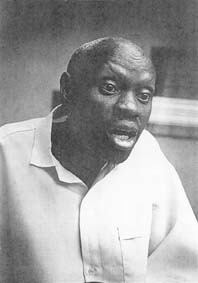Noël (Noheli) Hitimana (born Nyamirambo[3]) was a presenter (animateur) on the Rwandan radio station Radio Télévision Libre des Mille Collines (RTLM), which played a significant role in promoting the genocide against the Tutsi. Like the station's other broadcasters, Hitimana incited violence against the Tutsi on the air.[1]
Noël (Noheli) Hitimana | |
|---|---|
 | |
| Born | c. 1955 |
| Died | 2002[1][2] Rwanda (in prison) |
| Occupation(s) | Radio presenter (animateur), journalist |
Prior to his employment at RTLM, Hitimana worked for state-owned Radio Rwanda and the Rwanda Bureau of Information and Broadcasting from the late 1970s until the early 1990s. During that time, he became popular by routinely greeting the different regions and towns of Rwanda in the early morning, while farmers were waking to work in the fields. This broadcast segment emphasized both the importance of hard work, community and the nationalistic views of the ruling National Republican Movement for Democracy and Development (MRND). Allegedly a drunk, Hitimana was fired from Radio Rwanda after insulting Rwandan President Juvénal Habyarimana on-air while intoxicated.[1]
Due to his popularity throughout the country, Hitimana was one of the first animateurs hired by RTLM after its founding on 8 April 1993.[4] He continued his trademark practice of greeting towns and individuals. Once the Genocide against the Tutsi began on 7 April 1994, Hitimana modified this habit into naming exact locations and names of alleged RPF accomplices, inciting targeted violence and often murder on the named individuals by groups such as the Impuzamugambi and Interahamwe militias.[5]
Segments by Hitimana made up about 5% of all RTLM broadcasts.[4]: 117
The studio of RTLM was hit by a bomb on 17 April 1994, with Hitimana being seriously injured. Following the attack, his leg was amputated, resulting in Hitimana leaving RTLM for good.[4] Hitimana was interviewed by Yolande Mukagasana for her book The Wounds of Silence[6]
Hitimana allegedly died in a Rwandan prison in 2002 due to disease.[1][2][7]
References
edit- ^ a b c d Li, Darryl (2004). "Echoes of violence: Considerations on radio and genocide in Rwanda". Journal of Genocide Research. 6 (1): 25. doi:10.1080/1462352042000194683. S2CID 85504804. Retrieved 19 March 2013.
- ^ a b FH (27 February 2002). "CONVICTED ITALO-BELGIAN "HATE-RADIO" PRESENTER BEGINS TESTIMONY". Hirondelle News Agency. Retrieved 22 March 2013.[permanent dead link]
- ^ "Bene-Rwanda » 2009 » giugno".
- ^ a b c Thompson, Allan, ed. (2007). The Media and the Rwanda Genocide. Pluto Press, Fountain Publishers, IDRC. p. 325. ISBN 978-0-74532-625-2. Archived from the original on 16 September 2013. Retrieved 19 March 2013.
- ^ Cotton, Cassandra (2007). "'Where Radio is King': Rwanda's Hate Radio and the Lessons Learned". Atlantic International Studies Journal: 4–11. Archived from the original on 7 February 2013. Retrieved 17 March 2013.
- ^ "Le ferite del silenzio. Una mostra fotografica di Yolande Mukagasana e Alain Kazinierakis".
- ^ @NoelKambanda (29 September 2020). "Noël Hitimana who incited and promoted genocide against Tutsi on RTLM (Like Bemeriki and Kantano) told Yolande Muka…" (Tweet) – via Twitter.